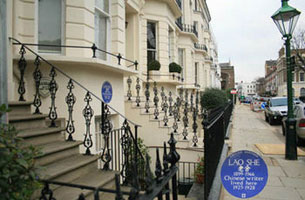 |
|
|
|
|||||||||||
In some other countries, former residences of famous people may also face demolition, but governments, social organizations and individuals make their own efforts to save them.
|
|
|
The former house of Chinese modern thinker and writer Lu Xun (1881-1936) in Sendai, Japan. [Photo/Xinmin Evening News] |
Japan
Government helps protect cultural properties
The Japanese government subsidizes owners of registered tangible cultural properties through tax breaks and repair subsidies. For example, owners pay half of the expenses for maintenance and repairs, and the other half is paid by the government.
However, owners undertake the corresponding liabilities. For example, owners need to announce to the government intended changes that affect more than 25 percent of the visible surface.
United Kingdom
Heritage Lottery Fund plays big role
|
 |
|
The former house of Chinese writer Lao She (the pen name of Shu Qingchun, 1899-1966) in London, England. [Photo/Xinmin Evening News] |
In London, archaic houses in red or white can be seen everywhere, and they are usually being repaired instead of being rebuilt.
The Heritage Lottery Fund (HLF) was set up by the government in 1994 to provide money for preservation. Since 1994, the fund has given grants totaling approximately £4.7 billion ($6.1 billion) to more than 32,000 projects.
Although HLF is not a government agency, the Department for Culture, Media and Sport issues financial and policy directions to the organization, which reports to Parliament through the department. In addition, any organizations or individuals can apply for heritage protection to the fund.
HLF makes protection plans for heritage after assessment without the involvement of the government, and offers grants of £3,000 ($3,902) to £5 million ($6.5 billion).
|
 |
|
The hotel where late premier Zhou Enlai (1898-1976) lived from 1922 to 1944 in Paris, France. [Photo/Xinmin Evening News] |
France
Multiple ways of protection
In France, chances are great that you have close contact with former homes of noted people, whether you are in a big city or in a remote village. They are cherished as treasures by the French.
Former residences of famous people are listed as cultural heritage sites. France was the first country to legislate the protection of cultural heritage. Early in 1887, they issued a law to preserve monumental architectures with historical and architectural value. After that, other laws were issued to sort, manage, register and renovate those structures.
Also, the preservation and renovation of former residences of famous people are run by professional architects, who avoid the risks of government's one-sided decisions.
Third, social forces encourage getting involved in preservation, through tax policy. Funds, enterprises and individuals getting involved can enjoy tax breaks. This has led to an increase in social donations for protection work.

|

|

|

|

|

|